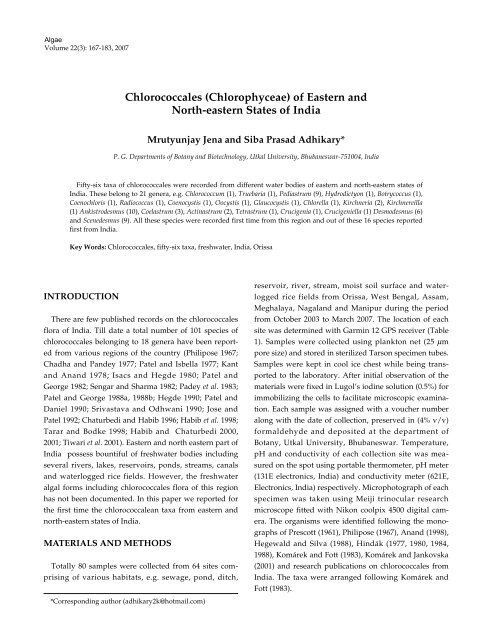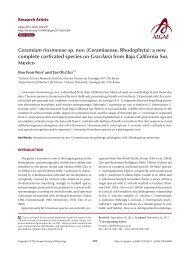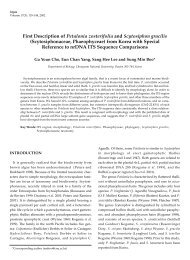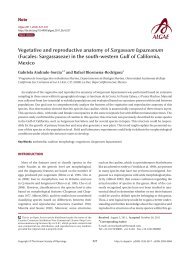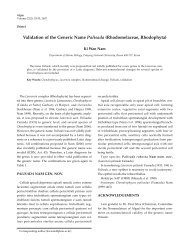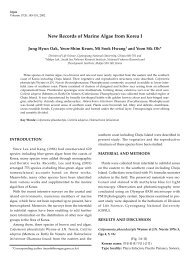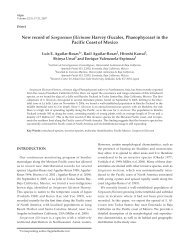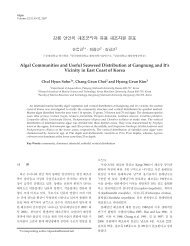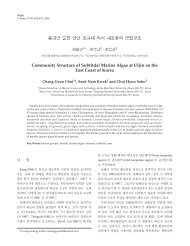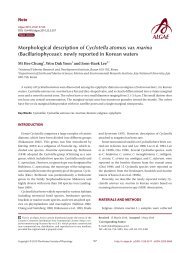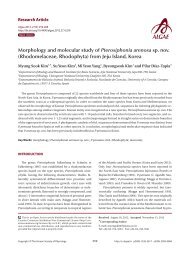Chlorococcales (Chlorophyceae) of Eastern and North ... - Algae
Chlorococcales (Chlorophyceae) of Eastern and North ... - Algae
Chlorococcales (Chlorophyceae) of Eastern and North ... - Algae
Create successful ePaper yourself
Turn your PDF publications into a flip-book with our unique Google optimized e-Paper software.
<strong>Algae</strong><br />
Volume 22(3): 167-183, 2007<br />
INTRODUCTION<br />
There are few published records on the chlorococcales<br />
flora <strong>of</strong> India. Till date a total number <strong>of</strong> 101 species <strong>of</strong><br />
chlorococcales belonging to 18 genera have been reported<br />
from various regions <strong>of</strong> the country (Philipose 1967;<br />
Chadha <strong>and</strong> P<strong>and</strong>ey 1977; Patel <strong>and</strong> Isbella 1977; Kant<br />
<strong>and</strong> An<strong>and</strong> 1978; Isacs <strong>and</strong> Hegde 1980; Patel <strong>and</strong><br />
George 1982; Sengar <strong>and</strong> Sharma 1982; Padey et al. 1983;<br />
Patel <strong>and</strong> George 1988a, 1988b; Hegde 1990; Patel <strong>and</strong><br />
Daniel 1990; Srivastava <strong>and</strong> Odhwani 1990; Jose <strong>and</strong><br />
Patel 1992; Chaturbedi <strong>and</strong> Habib 1996; Habib et al. 1998;<br />
Tarar <strong>and</strong> Bodke 1998; Habib <strong>and</strong> Chaturbedi 2000,<br />
2001; Tiwari et al. 2001). <strong>Eastern</strong> <strong>and</strong> north eastern part <strong>of</strong><br />
India possess bountiful <strong>of</strong> freshwater bodies including<br />
several rivers, lakes, reservoirs, ponds, streams, canals<br />
<strong>and</strong> waterlogged rice fields. However, the freshwater<br />
algal forms including chlorococcales flora <strong>of</strong> this region<br />
has not been documented. In this paper we reported for<br />
the first time the chlorococcalean taxa from eastern <strong>and</strong><br />
north-eastern states <strong>of</strong> India.<br />
MATERIALS AND METHODS<br />
<strong>Chlorococcales</strong> (<strong>Chlorophyceae</strong>) <strong>of</strong> <strong>Eastern</strong> <strong>and</strong><br />
<strong>North</strong>-eastern States <strong>of</strong> India<br />
Totally 80 samples were collected from 64 sites comprising<br />
<strong>of</strong> various habitats, e.g. sewage, pond, ditch,<br />
Mrutyunjay Jena <strong>and</strong> Siba Prasad Adhikary*<br />
P. G. Departments <strong>of</strong> Botany <strong>and</strong> Biotechnology, Utkal University, Bhubaneswar-751004, India<br />
Fifty-six taxa <strong>of</strong> chlorococcales were recorded from different water bodies <strong>of</strong> eastern <strong>and</strong> north-eastern states <strong>of</strong><br />
India. These belong to 21 genera, e.g. Chlorococcum (1), Truebaria (1), Pediastrum (9), Hydrodictyon (1), Botrycoccus (1),<br />
Coenochloris (1), Radiococcus (1), Coenocystis (1), Oocystis (1), Glaucocystis (1), Chlorella (1), Kirchneria (2), Kirchnereilla<br />
(1) Ankistrodesmus (10), Coelastrum (3), Actinastrum (2), Tetrastrum (1), Crucigenia (1), Crucigeniella (1) Desmodesmus (6)<br />
<strong>and</strong> Scenedesmus (9). All these species were recorded first time from this region <strong>and</strong> out <strong>of</strong> these 16 species reported<br />
first from India.<br />
Key Words: <strong>Chlorococcales</strong>, fifty-six taxa, freshwater, India, Orissa<br />
*Corresponding author (adhikary2k@hotmail.com)<br />
reservoir, river, stream, moist soil surface <strong>and</strong> waterlogged<br />
rice fields from Orissa, West Bengal, Assam,<br />
Meghalaya, Nagal<strong>and</strong> <strong>and</strong> Manipur during the period<br />
from October 2003 to March 2007. The location <strong>of</strong> each<br />
site was determined with Garmin 12 GPS receiver (Table<br />
1). Samples were collected using plankton net (25 µm<br />
pore size) <strong>and</strong> stored in sterilized Tarson specimen tubes.<br />
Samples were kept in cool ice chest while being transported<br />
to the laboratory. After initial observation <strong>of</strong> the<br />
materials were fixed in Lugol’s iodine solution (0.5%) for<br />
immobilizing the cells to facilitate microscopic examination.<br />
Each sample was assigned with a voucher number<br />
along with the date <strong>of</strong> collection, preserved in (4% v/v)<br />
formaldehyde <strong>and</strong> deposited at the department <strong>of</strong><br />
Botany, Utkal University, Bhubaneswar. Temperature,<br />
pH <strong>and</strong> conductivity <strong>of</strong> each collection site was measured<br />
on the spot using portable thermometer, pH meter<br />
(131E electronics, India) <strong>and</strong> conductivity meter (621E,<br />
Electronics, India) respectively. Microphotograph <strong>of</strong> each<br />
specimen was taken using Meiji trinocular research<br />
microscope fitted with Nikon coolpix 4500 digital camera.<br />
The organisms were identified following the monographs<br />
<strong>of</strong> Prescott (1961), Philipose (1967), An<strong>and</strong> (1998),<br />
Hegewald <strong>and</strong> Silva (1988), Hindák (1977, 1980, 1984,<br />
1988), Komárek <strong>and</strong> Fott (1983), Komárek <strong>and</strong> Jankovska<br />
(2001) <strong>and</strong> research publications on chlorococcales from<br />
India. The taxa were arranged following Komárek <strong>and</strong><br />
Fott (1983).
168 <strong>Algae</strong> Vol. 22(3), 2007<br />
Table. 1. List <strong>of</strong> the sites <strong>of</strong> collection showing latitude, longitude, voucher number, nature <strong>of</strong> the habitat/area (approx.) in hectare<br />
Station no.(S) Place <strong>of</strong> collection Latitude Longitude Voucher no. Habitat/area<br />
1 Satsanga vihar, Bhubaneswar, Orissa 20° 20’ 4.4” N 85° 44’ 88” E B 33 Small pond (0.25 ha)<br />
2 Nicco park, Acharya vihar, Bhubaneswar 20° 17’ 07”N 85° 50’ 39.3” E B107 Small garden tank<br />
3 Acharya vihar, Bhubaneswar 20° 17’ 7.8” N 85° 50’ 59.3”E B110 Sewage tank (small)<br />
4 Rameswar temple tank, Khurda, Orissa 20° 19’ 54.6”N 85° 59’ 83.1” E 144B Pond (1 ha)<br />
5 Kathajodi river, Cuttack, Orissa 20°27’ 28”N 85° 52’ 46.6”E 240,244, 246,249 Perennial River<br />
6 Manguli Dam, Cuttack, Orissa 20° 27’ 27”N 85° 52’ 41.6”E 547 Reservoir (20 ha)<br />
7 Niali, Jagatsingpur Orissa 20° 07’ 41.1”N 86° 08’ 48.6”E 89 Pond (2 ha)<br />
8 Gopinathpur, Jagatsingpur, Orissa 20° 19’ 07.9”N 86° 11’ 39.3” E 88 Pond (1 ha)<br />
9 Maniakati, Ganjam, Orissa 19° 48’ 78.8”N 84° 22’ 46.3”E 107 Pond (1 ha)<br />
10 Nirmalajhara, Ganjam, Orissa 19° 36’ 14.1”N 85° 04’ 03” E 125 Perennial stream<br />
11 Chikiti, Ganjam, Orissa 20° 32’ 23.2”N 83° 24’ 42.0”E 737, 750 Pond (small)<br />
12 Stream,Shilong, Meghalaya 25°20’ 20.3”N 91° 43’ 46.1”E 351 Perennial stream<br />
13 River Mahanadi, Sambalpur, Orissa 21°26’ 59.2”N 84° 00’ 12.6”E 436 Perennial river<br />
14 Road side, Padpadar, Baragarh, Orissa 21°19’ 52.3”N 83° 37’ 13”E 444 Temporary water pool<br />
15 Padpadar, Baragarh, Orissa 21°19’ 58.4”N 83° 37’ 10.6”E 445 Pond (0.5 ha)<br />
16 Garab<strong>and</strong>ha,Gajapati, Orissa 18° 51’ 06.7”N 84° 12’ 8.8”E 617 Pond (0.25 ha)<br />
17 Lanjigada, Kalah<strong>and</strong>i, Orissa 19° 42’ 22.9”N 83° 22’ 03.7”E 675 Pond (0.25 ha)<br />
18 Lunung, Similipal Biosphere Reserve, 22° 06’ 15”N 86° 31’ 11”E 762 Perennial stream<br />
Mayurbhanj, Orissa<br />
19 Jor<strong>and</strong>a, Similipal Biosphere Reserve, Orissa 22° 12’ 21”N 86° 28’ 31”E 763 Perennial stream<br />
20 Nawna, Similipal Biosphere Reserve, Orissa 22° 09’ 23”N 86° 30’ 21”E 764 Pond (0.25 ha)<br />
21 Khairi rever , Similipal Biosphere Reserve, 22° 15’ 20”N 86° 34’ 23”E 766 Perennial river<br />
Orissa<br />
22 Bh<strong>and</strong>an river, Similipal Biosphere Reserve, 22° 19’ 23”N 86° 29’ 27”E 767 Perennial river<br />
Orissa<br />
23 West Deo river, Similipal Biosphere, Orissa 22° 10’ 27”N 86° 38’ 40”E 769 Perennial river<br />
24 Rice field, Bhogarai, Balasore, Orissa 21°54’ 36.4”N 87° 21’ 05.1”E 197 Rice field (0.2 ha)<br />
25 Krishna sayar park, Burdwan, West bengal 23° 14’ 86.3”N 87° 50’ 89.1”E 700,701, 702 Pond (2 ha)<br />
26 Santiniketan, Birbhum, West bengal 23° 39’ 39.6”N 87° 42’ 20.8”E 711 Pond (1 ha)<br />
27 Kalnabipass, Assam, Burdwan, West Bengal 23° 41’ 28.8 “N 86° 59’ 38”E 861 Polluted canal<br />
28 Brahmaputra river, Guwahati, Assam 26° 10’ 49”N 91° 40’ 17.1”E 919, 920 Perennial river<br />
29 Barik nagar, Cachar, Assam 24° 44’ 3.5”N 92° 47’ 32.2”E 933, 934 Small pond (0.5 ha)<br />
30 Silkuri, Cachar, Assam 24° 43’ 49.8”N 92° 47’ 16”E 946, 948 Small pond (0.5 ha)<br />
31 Silkuri, Near Baramhaha M<strong>and</strong>ir, Cachar, 24° 43’ 49.3”N 92° 47’ 15.3” E 950 Pond (3 ha)<br />
Assam<br />
32 Machhghat, Silchar, Cachar, Assam 24° 42’ 25”N 92° 46’ 06.1” E 963, 964 Puddle (0.2 ha)<br />
33 Irongmona gaon, Silchar, Cachar, Assam 24° 40’ 59.2”N 92° 44’ 32.2”E 967, 968 Pond (0.5 ha)<br />
34 Roskendi, Tea garden, Silchar, Assam 24° 41’ 12.2”N 92° 43’ 22.3” E 970 Pond (1 ha)<br />
35 Dobanki (isl<strong>and</strong>) Tiger reserve, Sudarban, 21° 59’ 21”N 88° 45’ 17.4”E 978, 979 Small pond (0.2 ha)<br />
West Bengal<br />
36 Pakhirala, South 24-Parganas, West Bengal 22° 07’ 47.8”N 88° 49’ 21.9” E 985, 987 Small pond (0.25 ha)<br />
37 Pakhirala, South 24-Parganas, West Bengal 22° 07’ 47.8” N 88° 49’ 21.9” E 988 Temporary water pool<br />
38 Masjidbadi, South 24-Parganas, West Bengal 22° 10’ 36” N 88° 46’ 20.16”E 994 Small pond (0.3 ha)<br />
39 Kalibartala, South 24-Parganas, West Bengal 22° 14’ 24.7”N 88° 41’ 32.7”E 1007 Temporary water pool<br />
40 Sultanpur, Diom<strong>and</strong> habour, South 24- 22° 10’ 27.1” N 88° 12’ 15.5”E 1018 Sewage Temporary<br />
Parganas, West Bengal polluted water)<br />
41 Ratneswarpur, Diom<strong>and</strong> habour, South 24- 22° 11’ 34.8”N 88° 12’ 36.3”E 1025 Small pond (0.5 ha)<br />
Parganas, West Bengal<br />
42 Sultanpur, Diom<strong>and</strong> habour, South 24- 22° 19’ 11.4” N 88° 12’ 12.8”E 1028 Temporary water pool<br />
Parganas, West Bengal<br />
43 Chiranjibipur, Haldia Purba Medinipur, 22° 03’ 13.1” N 88° 05’ 31.6”E 1047 Temporary water pool<br />
West Bengal<br />
44 Sciencity, Salt lake, Kolkata, West Bengal 22° 32’ 29.7” N 88° 23’ 47.4”E 1068, 1069 Drain (Polluted water)
Table. 1. (continued)<br />
RESULTS AND DISCUSSION<br />
Details about the sites <strong>of</strong> collection, habitat, pH, temperature<br />
<strong>and</strong> conductivity <strong>of</strong> water at the time <strong>of</strong> collection<br />
<strong>and</strong> voucher number <strong>of</strong> each sample have been<br />
depicted in Table 1. Totally 56 taxa <strong>of</strong> chlorococcales<br />
belonging to 21 genera were recorded from several freshwater<br />
bodies <strong>of</strong> eastern <strong>and</strong> north-eastern states <strong>of</strong> India.<br />
Out <strong>of</strong> these 16 species, e.g. Treubaria setigera (Archer)<br />
G.M. Smith, Pediastrum simplex Meyen var. biwaense<br />
Fukushima, Pediastrum simplex Meyen var. echinulatum<br />
Wittrocck, Coenochloris polycocca (Korsˇikov) Hindák,<br />
Radiococcus nimbatus (De Wildeman) Scmidle, Coenocystis<br />
reniformis Korsˇikov <strong>and</strong> Oocystis rhomboidea Fott,<br />
Glaucocystis simplex Tarnogradskij, Monoraphidium contortum<br />
(Thuret) Komárková <strong>and</strong> Legnerová, Ankistrodesmus<br />
densus Koráikov, Ankistrodesmus fusiformis Corda,<br />
Ankistrodesmus stipitatus (Chodat) Komárek <strong>and</strong><br />
Legnerova, Ankistrodesmus tortus Komárek et Comas,<br />
Actinastrum aciculare Playfair f. Minimum (Huber-<br />
Pestalozzi) Compère, Tetrastrum elegans Playfair,<br />
Desmodesmus protuberans (Fritsch et Ritch) Hegewald <strong>and</strong><br />
Jena & Adhikary: <strong>Chlorococcales</strong> from India 169<br />
Station no.(S) Place <strong>of</strong> collection Latitude Longitude Voucher no. Habitat/area<br />
45 Danuswari river, Dimapur, Nagal<strong>and</strong> 25° 54’ 46.8” N 93° 44’ 36.1” E 1084 Perennial river<br />
46 Purana Bazar, Dimapur, Nagal<strong>and</strong> 25° 53’ 44.4” N 93° 45’ 16.7”E 1089 Small pond (0.5 ha)<br />
47 Green park, Dimapur, Nagal<strong>and</strong> 25° 51’ 30.7”N 93° 45’ 50.7”E 1099 Temporary water pool<br />
48 Green park, Dimapur, Nagal<strong>and</strong> 25° 51’ 30.7” N 93° 45’ 50.7”E 1101 Temporary water poo<br />
49 Imphal river, Imphal, Manipur 24° 48’ 09”N 93° 56’ 53”E 1112, 1113 Perennial river<br />
50 Loktak lake, Sedra, Manipur 24° 30’ 26.7”N 93° 47’ 04.1”E 1118 Largest lake (87.000 sq.<br />
miles)<br />
51 Dikho river, Sibsagar, Assam 26° 58’ 30”N 94° 37’ 46.9”E 1133 Perennial river<br />
52 Jaysagar, Jorhat, Assam 26° 57’ 12.3”N 94° 37’ 37.4”E 1134, 1135 Pond (5 ha)<br />
53 Road side canal, Jaysagar, Jorhat, Assam 26° 57’ 12.3” N 94° 37’ 37.4”E 1140 Canal (flowing water)<br />
54 Jaji river, Jorhat, Assam 26° 50’ 49.6” N 94° 26’ 30.7”E 1144 Perennial river<br />
55 Mahi lake, Kajiranga National Park, Assam 26° 36’ 41.1” N 93° 22’ 40.5”E 1148 Lake (70 ha)<br />
56 Kaulimardi lake, Kajiranga Nation Park, 26° 38’ 45.3” N 93° 20’ 51.7”E 1149 Lake (50 ha)<br />
Assam<br />
57 Diffolo river, Kajiranga National Park, 26° 38’ 45.3” N 93° 20’ 51.7”E 1153 Perennial river<br />
Assam<br />
58 Dhonsiri river, Numaligarh, Assam 26° 27’ 51.4” N 93° 43’ 46.4”E 1160, 1162 Perennial River<br />
59 Brahmaputra river, Namati, Jorhat, Assam 26° 51’ 34.5” N 94° 14’ 48.9” E 1167 Perennial River<br />
60 Brahmaputra river, Majuli river isl<strong>and</strong>, 26° 52’ 49” N 94° 12’ 55.7”E 1170 Perennial River<br />
Assam<br />
61 Sri Sri Aunikati Sastra, Majuli river isl<strong>and</strong>, 26° 56’ 18.3” N 94° 07’ 24.0”E 1178 Small pond (0.5 ha)<br />
Assam<br />
62 Kamadubedi, Jorhat, Assam 26° 56’ 18.3” N 94° 07’ 24.0”E 1179 Small pond (0.5 ha)<br />
63 Brahmaputra river, Fancy Bazar, Guwahati, 26° 5’ 52.7 “N 91° 30’ 23.7”E 1187, 1188 Perennial River<br />
Assam<br />
64 Utkal University, Bhubaneswar, Orissa 20° 20’ 6.4” N 85° 44’ 48” E 541 Temporary water pool<br />
Scenedesmus pseudopoliensis Hortobagyi are reported first<br />
time from India. Description <strong>of</strong> each species <strong>and</strong> systematic<br />
enumeration is presented.<br />
Family: Chlorococcaceae Lackman <strong>and</strong> Tansley 1902.<br />
Sub family: Chlorococcoideae<br />
Genus: Chlorococcum Meneghini 1842<br />
1. Chlorococcum humicolo (Nägeli) Rabenhorst 1868 (Pl.<br />
1, Fig. 1)<br />
[Synonym: Chlorococcum humicolum (Nägeli)<br />
Rabenhorst 1915, Cystococcus humiccolo Nägeli 1849]<br />
Philipose 1967, p. 73, fig. 3 (b), Prescott 1961, p. 212,<br />
pl. 45, fig.1.<br />
Cells spherical, solitary or number <strong>of</strong> cells crowded<br />
together to form a stratum; chloroplast a hollow sphere<br />
with a lateral notch, cells 6-25 µm in diameter, zoospores<br />
elliptical, 4.5 µm broad <strong>and</strong> 3-4 µm long.<br />
Epiphytic in stream <strong>and</strong> planktic in river; Voucher<br />
number, date <strong>and</strong> site: 351; 6 th Dec. 2004; Shilong,<br />
Meghalaya (S-12; Temp. 25°C; pH 7.1; Cond. 150 µs);<br />
1170; 29 th March 2007; Majuli river isl<strong>and</strong>, Assam (S-60).<br />
Family: Treubariaceae (Korˇsikov) Fott 1960
170 <strong>Algae</strong> Vol. 22(3), 2007<br />
Plate 1. (Figs 1-18) 1. Chlorococcum humicolo (Näg.) Rabenh., 2. Treubaria setigera (Arch.) G.M. Sm., 3. Pediastrum duplex Mey. var. asperum<br />
(A. Br.) Hansg. 4. Pediastrum duplex Mey. var. cornutum (Racib.) Sulek, 5. Pediastrum duplex Mey. var. duplex Sulek, 6-7.<br />
Pediastrum simplex Mey. var. biwaense Fukush., 8-9. Pediastrum simplex Mey. var. echinulatum Wittr., 10. Pediastrum simplex Mey.<br />
var. pseudoglabrum Parra, 11. Pediastrum simplex Mey. var. simplex Kom., 12. Pediastrum simplex Mey. var. sturmii (Reins.) Wolle,<br />
13-14. Pediastrum tetras (Ehrenb.) Ralfs, 15. Hydrodictyon reticulatum (Linn.) Lagerh., 16-17. Botrycoccus braunii Kütz. 18.<br />
Coenochloris polycocca (Korsˇ.) Hind. (Scale bar; Figs 1-18 = 10 µm).
Sub-family: Treubarioideae Korˇsikov<br />
Genus: Treubaria Berbard emend Reymond 1979<br />
[Synonym: Borgea G.M. Smith 1922]<br />
2. Treubaria setigera (Archer) G.M. Smith 1933 (Pl. 1,<br />
Fig. 2)<br />
[Basionym: Tetrapedia setigera W. Archer 1872]<br />
[Synonym: Tertraedron trilobulatum (Reinsch) Hansgirg<br />
1888]<br />
Komárek <strong>and</strong> Fott 1983, p. 267, fig. 79.3, Philipose<br />
1967, p. 137, fig. 50.<br />
Cells solitary, free floating, triangular, sides equal in<br />
length, <strong>and</strong> deeply concave, angles <strong>of</strong> cells broadly<br />
rounded; cell membrane thick <strong>and</strong> smooth; chloroplast<br />
single discoid form without pyrenoid; cells up to 25 µm<br />
in diameter.<br />
Planktic in pond, river <strong>and</strong> canal; Voucher numbers,<br />
dates <strong>and</strong> sites: 737, 750; 14 th Jan. 2006; Berhampur;<br />
Orissa (S-11; Temp. 27°C; pH 7.9; Cond. 445 µs); 1113;<br />
24 th March 2007; Imphal, Manipur (S-49; Temp. 26°C; pH<br />
7.7; Cond. 201 µs).<br />
Family: Hydrodictyaceae Cohn 1880<br />
Genus: Pediastrum Meyen 1829<br />
3. Pediastrum duplex Meyen var. asperum (A. Braun)<br />
Hansgirg 1886 ( Pl. 1, Fig. 3)<br />
[Synonym: Pediastrum pertusum var. asperum A. Braun<br />
1855]<br />
Philipose 1967, p. 121, fig. 43; Komárek <strong>and</strong> Fott 1983,<br />
p. 301-302, fig. 90.3; Komárek <strong>and</strong> Jankovska 2001, p. 58,<br />
fig. 34.<br />
Coenobia 16-32-64 celled, 90 µm in diameter, small<br />
lens shaped perforation between cells, inner cells<br />
quadrate to angular <strong>and</strong> in contact at the central portion<br />
<strong>of</strong> the side wall, inner side <strong>of</strong> marginal cells concave,<br />
outer sides produced into two short truncate processes;<br />
chloroplast single <strong>and</strong> parietal with a pyrenoid; cells 8-18<br />
µm in diameter.<br />
Epiphytic (attached to leaf), epipelic in wet soil <strong>and</strong><br />
s<strong>and</strong> in river; Voucher number, date <strong>and</strong> site: B33; 20 th<br />
Jan. 2004; Bhubaneswar, Orissa (S-1; Temp. 28°C; pH 7.5;<br />
Cond. 300 µs); 246; 18 th April 2004; Cuttack, Orissa (S-5;<br />
Temp. 30°C, pH 7.5; Cond. 221 µs).<br />
4. Pediastrum boryanum (Turpin) Meneghini var. cornutum<br />
(Raciborski) Sulek 1969 (Pl. 1, Fig. 4)<br />
[Basionym: Pediastrum duplex Meyen var. conrutum<br />
(Raciborski) Sulek 1890]<br />
Komárek <strong>and</strong> Fott 1983, p. 296, fig. 87.2.<br />
Coenobia 16-32-64 celled <strong>and</strong> more, coenobia 120 -214<br />
µm in diameter, inner cells four cornered with a small<br />
Jena & Adhikary: <strong>Chlorococcales</strong> from India 171<br />
lens-shaped perforation in front <strong>and</strong> another at the back,<br />
marginal cells slightly longer than broad, lateral cells in<br />
contact along one third the length, processes <strong>of</strong> marginal<br />
cells ending in short spines; chloroplast single, parietal<br />
with a pyrenoid; cells 12-15 µm broad <strong>and</strong> 15-25 µm<br />
long.<br />
Epiphytic in pond (attached to leaf); Voucher number,<br />
date <strong>and</strong> site: B33; 20 th Jan. 2004; Bhubaneswar, Orissa<br />
(S-1; Temp. 28°C; pH 7.5; Cond. 300 µs).<br />
5. Pediastrum duplex Meyen var. duplex Sulek 1969 (Pl.<br />
1, Fig. 5)<br />
[Synonym: Pediastrum pertusum Kützing 1845]<br />
Komárek <strong>and</strong> Jankovska 2001, p. 58, fig. 32.<br />
Coenobia 16 celled, 50 -70 µm in diameter, intercellular<br />
spaces large <strong>and</strong> oval in between the inner cells; cells<br />
more or less H-shaped with marginal sides, cells nearly<br />
parallel; chloroplast single <strong>and</strong> parietal with a distinct<br />
pyrenoid; cells 12-15 µm in diameter.<br />
Epiphytic in pond (attached to leaf) <strong>and</strong> in lake;<br />
Voucher number, date <strong>and</strong> site: B33; 20 th Jan. 2004;<br />
Bhubaneswar, Orissa (S-1; Temp. 28°C; pH 7.5; Cond.<br />
300 µs); 1118; 25 th March 2007; Loktak lake, Manipur (S-<br />
50; Temp. 25°C; pH 7.8; Cond. 123 µs);1135; 27 th March<br />
2007; Jaysagar, Assam (S-52; Temp. 25°C; pH 7.5; Cond.<br />
190 µs).<br />
6. Pediastrum simplex Meyen var. biwaense Fukushima<br />
1953* (Pl. 1, Figs 6 & 7)<br />
Komárek <strong>and</strong> Fott 1983, p. 290, fig. 85.2.<br />
Coenobia 16-32 or more celled, circular; large intercellular<br />
spaces or a single central space with the cells<br />
arranged in a ring at the periphery; inner face <strong>of</strong> marginal<br />
cells concave, outer face prolonged into a single tapering<br />
processes; side <strong>of</strong> marginal cells concave on nearly<br />
straight; inner cell cells similar to marginal cells but short<br />
in processes; cell wall smooth or slightly punctuate; cells<br />
7- 20 µm broad <strong>and</strong> 10-35 µm long; coenobia up to 130<br />
µm in diameter.<br />
Planktic in river; Voucher number, date <strong>and</strong> site: 1162;<br />
28 th March 2007; Golaghat, Assam (S-58); 1167; 29th March 2007; Jorhat, Assam (S-59).<br />
7. Pediastrum simplex Meyen var. echinulatum Wittrock<br />
1983 (Pl. 1, Figs 8 & 9)<br />
Komárek <strong>and</strong> Fott 1983, p. 288, fig. 85.1, Krienitz et al.<br />
1998, p.66, fig. 6a.<br />
Coenobia mostly 4-celled, the cells are arranged in a<br />
plate , which is continuous or with interstices; outer cells<br />
have one elongated outward pointing process, inner cell<br />
polygonal, cell wall surface <strong>of</strong> each cell is ornamented<br />
with teeth like protuberance; teeth 1-1.5 µm long; cells 6-
172 <strong>Algae</strong> Vol. 22(3), 2007<br />
10 µm broad <strong>and</strong> 10-25 µm long.<br />
Planktic in pond; Voucher number, date <strong>and</strong> site: 1101;<br />
22 nd March 2007; Dimapur, Nagal<strong>and</strong> (S-48; Temp. 28°C;<br />
pH 7.3; Cond. 170 µs).<br />
8. Pediastrum simplex Meyen var. pseudoglabrum Parra<br />
1979 (Pl. 1, Fig. 10)<br />
Komárek <strong>and</strong> Jankovska 2001, p. 32, fig.12c.<br />
Coenobia 8-16 celled, cells arranged in a ring round a<br />
central space with one or more interior cells <strong>and</strong> a number<br />
<strong>of</strong> marginal cells, perforate; central cell convex, cell<br />
wall smooth; chloroplast single parietal with a large<br />
pyrenoid; 8 celled coenobia up to 80 µm <strong>and</strong> 16 celled<br />
coenobia up to 100 µm in diameter; cells 8.5-18 µm broad<br />
<strong>and</strong> 14-37 µm long.<br />
Epilithic in waterfall <strong>and</strong> planktic in pond; Voucher<br />
number, date <strong>and</strong> site: 617; 26 th Oct. 2005; Garab<strong>and</strong>ha,<br />
Gajapati, Orissa (S-16; Temp. 29°C; pH 7.6; Cond. 279<br />
µs).<br />
9. Pediastrum simplex Meyen var. simplex Komárek 1983<br />
(Pl. 1, Fig. 11)<br />
[Synonym: Pediastrum ovatum (Ehrenberg) A. Braun<br />
1855]<br />
Komárek <strong>and</strong> Jankovska 2001, p. 32-33, fig. 12.A.<br />
Coenobia circular, 8-16 celled coenobia up to 80-85 µm<br />
in diameter; large intercellular spaces or a central space<br />
with the cells arranged in a ring at the periphery, inner<br />
side <strong>of</strong> marginal cells concave, outer surface prolonged<br />
into a single delicately tapering process, sides <strong>of</strong> marginal<br />
cells concave or straight, internal cells similar to marginal<br />
cells with shorter process, cell wall smooth; chloroplast<br />
single <strong>and</strong> parietal; cells 12-15 µm broad <strong>and</strong> 20-25<br />
µm long.<br />
Epilithic in pond, road side ditch <strong>and</strong> reservoir;<br />
Voucher number, date <strong>and</strong> site: 143B; 5 th Feb. 2004;<br />
Khurda, Orissa (S-4; Temp. 27°C; pH 7.2; Cond. 275 µs);<br />
444, 28 th March 2005, Baragarh, Orissa (S-14; Temp. 30°C;<br />
pH 7.4; Cond. 400 µs); 547; 5 th Oct. 2005; Cuttack, Orissa<br />
(S-6; Temp. 26°C; pH. 8.3; Cond. 121 µs); 988; 3rd March<br />
2007; South 24-Parganas , West Bengal (S-37; Temp. 28°C;<br />
pH 7.3; Cond. 220 µs).<br />
10. Pediastrum simplex Meyen var. sturmii (Reinsch)<br />
Wolle 1887 (Pl. 1, Fig. 12)<br />
[Synonym: Pediastrum sturmii Reinsch 1867, Pediastrum<br />
sturmii var. crenulatum Prescott 1965]<br />
Komárek <strong>and</strong> Fott 1983, p. 288, fig. 84.2; Komárek <strong>and</strong><br />
Jankovska 2001, p. 34, pl. 7.<br />
Coenobia 8-16 celled, inner side <strong>of</strong> marginal cells nearly<br />
straight, outer side produced into a gradually tapering<br />
process, sides concave, cells polygonal, cells in contact<br />
with adjacent cells without intercellular spaces; chloroplast<br />
single <strong>and</strong> parietal, cell wall smooth, cells 5-13 µm<br />
broad <strong>and</strong> 20-30 µm long.<br />
Planktic in pond; Voucher number, date <strong>and</strong> site: 617;<br />
26 th Oct. 2005; Garab<strong>and</strong>ha, Gajapati, Orissa (S-16; Temp.<br />
29°C; pH 7.6; Cond. 279 µs).<br />
11. Pediastrum tetras (Ehrenberg) Ralfs 1844 (Pl. 1, Fig.<br />
13, 14)<br />
[Basionym: Micrasterias tetras Ehrenberg 1838]<br />
[Synonym: Pediastrum rotula Kützing 1845, Pediastrum<br />
ehrenbergii (Corda) A. Braun 1855, Pediastrum incavatum<br />
Turner 1892]<br />
Philipose 1967, p. 128, fig. 45(b); Komárek <strong>and</strong><br />
Jankovska 2001, p. 68, fig. 43.<br />
Coenobia circular, 8 celled, 20-33 µm in diameter,<br />
coenobia a flat plate; cells without intercellular spaces;<br />
marginal cells divided into two lobes with a deep single<br />
linear incision, inner cells 4-6 sided with a single linear<br />
incision, cells 6-8 µm in diameter.<br />
Epilithic <strong>and</strong> planktic in pond; Voucher number, date<br />
<strong>and</strong> site: 702; 28 th Nov. 2005; Santiniketan, West Bengal<br />
(S-25; Temp. 25°C; pH 8.6; Cond. 379 µs); 985; 3 rd March<br />
2007; South 24-Parganas, West Bengal (S-36; Temp. 26°C,<br />
pH 7.7, Cond 210 µs); 994; 3 rd March 2007; South 24-<br />
Parganas, West Bengal (S-38; Temp. 27°C; pH 7.3; Cond.<br />
210 µs).<br />
Genus: Hydrodictyon Roth 1800<br />
12. Hydrodictyon reticulatum (Linnaeus) Lagerheim<br />
1883 (Pl. 1, Fig. 15)<br />
[Basionym: Conferva reticulatum Linnaeus 1753]<br />
[Synonym: Hydrodictyon pentagonum Voucher 1800]<br />
Philipose 1967, p. 134, fig. 48 (a); Komárek <strong>and</strong> Fott<br />
1983, p. 317, fig. 95.2.<br />
Coenobia reticulate net-like, meshes pentagonal or<br />
hexagonal, up to 15-20 cm long; cells elongate-cylindrical,<br />
coenocytes with large central vacuole, cell wall two<br />
layered; chloroplast single, parietal <strong>and</strong> with a single<br />
pyrenoid; cells up to 250 µm broad <strong>and</strong> up to 1.5-2 cm<br />
long.<br />
Epiphytic in rice field, free floating in stagnant water<br />
in river; Voucher number, date <strong>and</strong> site: 197; 2 nd March<br />
2004; Balasore, Orissa (S-24; Temp. 29°C; pH 7.4; Cond.<br />
395 µs); 249; 18th April, 2004; Cuttack, Orissa (S-5; Temp.<br />
30°C, pH 7.5; Cond. 221 µs); 920; 2nd Dec. 2006;<br />
Guwahati, Assam (S-28; Temp. 24°C; pH 7.4; Cond. 186<br />
µs);1084; 22 nd March 2007; Dimapur, Nagal<strong>and</strong> (S-45,<br />
Temp. 28°C, pH 7.7, Cond. 204 µs); 1112, 1113; 24th March 2007; Imphal, Manipur (S-49; Temp. 26°C; pH 7.7;<br />
Cond. 201 µs); 1149; 28 th March 2007; Kajiranga National
Park, Assam (S-56); 1160, 1162; 28th March 2007;<br />
Golaghat, Assam (S-58); 1187, 1188; 30 th March 2007;<br />
Guwahati, Assam (S-63).<br />
Family: Botryocccaceae Wille 1909<br />
Sub family Botrycoccoidae<br />
Genus: Botrycoccus Kützing 1849<br />
[Synonym: Botryodictyon Lemmermann 1903,<br />
Botrysphaera Chodat 1922]<br />
13. Botrycoccus braunii Kützing 1849 (Pl. 1, Fig. 16 & 17)<br />
[Synonym: Botrycoccus giganteus Reinsch 1877]<br />
Komárek <strong>and</strong> Fott 1983, p. 379, fig. 113.4, Prescott,<br />
1961, p. 232, pl. 52, fig. 1 <strong>and</strong> 2, Philipose 1967, p. 195, fig.<br />
108, a <strong>and</strong> b.<br />
Coenobia in irregular shape, <strong>of</strong>ten united in compound<br />
net like aggregates by long delicate mucilaginous<br />
projections from the colonial envelope; cells ovoid or<br />
ellipsoid <strong>and</strong> arranged radially at the periphery <strong>of</strong> the<br />
coenobia, cells 2-6 µm broad, 4-13 µm long; simple<br />
coenobia up to 100 µm in diameter.<br />
Free floating in river; Voucher number; date <strong>and</strong> site:<br />
1179; 29 th March 2007; Jorhat, Assam (S-62); 1187, 1188;<br />
30 th March 2007; Guwahati, Assam (S-63).<br />
Family: Radiococcaceae Fott <strong>and</strong> Komárek 1979.<br />
(Synonym: Palmellaceae Lemmermann 1915,<br />
Loeocystidaceae Fott 1971, Palmogloecaceae Fott 1974).<br />
Genus: Coenochloris Korsˇikov 1953<br />
14. Coenochloris forttii (Hindák) Tsarenko 1990 (Pl. 1,<br />
Figs. 18)<br />
[Basionym: Coenococcus fottii Hindák 1977]<br />
[Synonym: Eutetramorus fottii (Hindák) Komárek,<br />
Sphaerocystis schroeteri Chodat]<br />
Coenobia spherical to irregularly spherical, 8 or 16<br />
celled, embedded in a mucilaginous slime layer; 18-30<br />
µm in diameter; each cell 7-9 µm in diameter; chloroplast<br />
one, parietal, with one pyrenoid.<br />
Planktic in pond <strong>and</strong> in river; Voucher number, date<br />
<strong>and</strong> site: B107; 25 th April 2004; Bhubaneswar, Orissa (S-2;<br />
Temp. 30°C; pH 7.7; Cond. 500); 763; 25 th Jan. 2005;<br />
Similipal Biosphere Reserve, Orissa (S-19; Temp. 26°C;<br />
pH 6.8; Cond. 140 µs); 768 & 769; 26 th Jan. 2005; Similipal<br />
Biosphere Reserve, Orissa (S-23; Temp. 28°C; pH 7.0;<br />
Cond. 390 µs).<br />
Genus: Radiococcus Schmidle 1902<br />
15. Radiococcus nimbatus (De Wildeman) Schmidle 1902<br />
(Pl. 2, Fig. 1)<br />
[Basionym: Pleurococcus nimbatus De-Wildeman 1893]<br />
Thompson 1959, p. 137, fig. 6.155; Komárek <strong>and</strong> Fott<br />
Jena & Adhikary: <strong>Chlorococcales</strong> from India 173<br />
1983, p. 399, fig.120.3.<br />
Coenobia 4 celled 14-20 µm in diameter; cells more or<br />
less pyramidal <strong>and</strong> angular remaining in a group;<br />
chloroplast single, parietal without pyrenoid; cells 5-12<br />
µm in diameter.<br />
Epilithic in drain; Voucher number, date <strong>and</strong> site:<br />
B110; 25 th April 2004; Bhubaneswar, Orissa (S-3; Temp.<br />
27°C; pH 7.7; Cond. 349).<br />
Genus: Coenocystis Korsˇikov 1953<br />
16. Coenocystis reniformis Korsˇikov 1953 (Pl. 2, Fig. 2)<br />
Komárek <strong>and</strong> Fott 1983, p. 412, fig. 124.3.<br />
Cells asymmetric; ellipsoidal, cell wall smooth, cells 3-<br />
6 µm in diameter; chloroplast one with a small pyrenoid.<br />
Planktic in pond <strong>and</strong> river; Voucher number, date <strong>and</strong><br />
site: 764; 25 th Jan. 2005; Similipal Biosphere Reserve,<br />
Orissa (S-20; Temp. 29°C; pH 7.1; Cond. 200 µs); 766; 25th Jan. 2005; Similipal Biosphere Reserve, Orissa (S-21;<br />
Temp. 28°C; pH 7.1; Cond. 300 µs); 769; 26 th Jan. 2005;<br />
Similipal Biosphere Reserve, Orissa (S-23; Temp. 28°C;<br />
pH 7.0; Cond. 390 µs).<br />
Family: Oocystaceae Bohlin 1901<br />
Sub-family: Oocystoideae<br />
Genus: Oocystis A. Braun 1855<br />
17. Oocystis rhomboidea Fott 1933 (Pl. 2, Fig. 3)<br />
[Synonym: Didymogenes dubia Fott 1923, Oocystis submarina<br />
Lagerheim var. variabilis Skuja 1956]<br />
Hindák 1977, p. 67, pl. 26; Komárek <strong>and</strong> Fott 1983, p.<br />
510, fig. 149.4.<br />
Coenobia 4-celled; cells elongated-oval with rounded<br />
ends 2-3 times as long as broad, 9-15.6 µm broad <strong>and</strong> 15-<br />
25 µm long; 4-celled embedded in a single sheath; coenobia<br />
25-35 µm broad <strong>and</strong> 30-50 µm long.<br />
Planktic in pond; Voucher number; date <strong>and</strong> site: 541;<br />
27 th Sept. 2005; Utkal University, Bhubaneswar, Orissa<br />
(S-64).<br />
Sub family: Glaucocystidoideae<br />
Genus: Glaucocystis Itzigsohn in Rabenhorst 1868<br />
18. Glaucocystis simplex Tarnogradskij 1959 (Pl. 1, Figs<br />
4, 5 & 6)<br />
Komárek <strong>and</strong> Fott 1983, p. 553, fig. 160.4.<br />
Coenobia 2-4 celled, enclosed within a mother cell<br />
wall; cells oblong-ellipsoid <strong>and</strong> with a number <strong>of</strong> radiating<br />
chromatophore like bodies inside, cells 10-16 µm<br />
broad <strong>and</strong> 20-30 µm long, coenobium 25-50 µm broad<br />
<strong>and</strong> 40-65 µm long.<br />
Epiphytic in pond <strong>and</strong> polluted drain; Voucher number,<br />
date <strong>and</strong> site: 946, 948; 3 rd Dec. 2006; Silkuri, Assam<br />
(S-30; Temp. 23°C; pH 7.6; Cond. 290 µs); 1018; 4 th March
174 <strong>Algae</strong> Vol. 22(3), 2007<br />
Plate 2. (Figs 1-20) 1. Radiococcus nimbatus (De Wild.) Schmid. 2. Coenocystis reniformis Korsˇ. 3. Oocystis rhomboidea Fott, 4-6.<br />
Glaucocystis simplex Tarnograd., 7. Chlorella vulgaris Beij., 8. Monoraphidium contortum (Thur.) Kom.-Legn., 9. Kirchneria irregularis<br />
(G.M. Sm.) Hind., 10. Kirchneria rotunda (Korsˇ.) Hind., 11. Kirchnereilla obesa (W. West) Schmid., 12. Ankistrodesmus bernardii Kom.,<br />
13. Ankistrodesmus bibraianus (Reins.) Korsˇ., 14-15. Ankistrodesmus densus Korsˇ., 16-17. Ankistrodesmus falcatus (Cord.) Ralfs, 18.<br />
Ankistrodesmus falcatus (Cord.) Ralfs var. radiatus (Chod.) Lemm., 19. Ankistrodesmus fusiformis Cord., 20. Ankistrodesmus gracilis<br />
(Reins.) Korsˇ. (Scale bar; Figs 1-18 = 10 µm).
2007; Diam<strong>and</strong> harbour, South 24-Parganas, West Bengal<br />
(S-40; Temp. 28°C; pH 8.2; Cond. 507 µs).<br />
Family: Chlorollaceae Brunnthal 1910<br />
Sub family: Chlorelloideae<br />
Genus: Chlorella Beijerinck 1890<br />
19. Chlorella vulgaris Beijerinck 1890 (Pl. 1, Fig. 7.)<br />
[Synonym: Chlorella pyrenoidosa Chik var. duplex<br />
(Kützing) West]<br />
Philipose 1967, p. 173, fig. 82(a); Komárek <strong>and</strong> Fott<br />
1983, p. 594, fig. 168.2.<br />
Cells solitary with a thin cell wall, spherical; chloroplast<br />
parietal, cup-shaped with a distinct central<br />
pyrenoid; cells 5-5.8 µm in diameter.<br />
Planktic in stream, river <strong>and</strong> in pond: Voucher number,<br />
date <strong>and</strong> site: 240; 18 th April 2004; Cuttack, Orissa (S-<br />
5; Temp. 30°C; pH 7.5; Cond. 221); 762; 25 th Jan. 2005;<br />
Similipal Biosphere Reserve, Orissa (S-18; Temp. 25°C;<br />
pH 6.6; Cond. 120); 767; 26 th Jan. 2005; Similipal<br />
Biosphere Reserve, Orissa (S-22; Temp. 27°C; pH 7.0;<br />
Cond. 245 µs); 1025; 4th March 2007; Diam<strong>and</strong> harbour,<br />
South 24-Parganas, West Bengal (S-41; Temp. 27°C; pH<br />
7.9; Cond. 230 µs); 1028; 4 th March 2007; Diam<strong>and</strong> harbour,<br />
South 24-Parganas, West Bengal (S-42; Temp. 27°C;<br />
pH 8.2; Cond. 215 µs).<br />
Family: Chlorollaceae Brunnthal 1910<br />
Sub family: Ankistrodesmoideae<br />
Genus: Monoraphidium 1969<br />
20. Monoraphidium contortum (Thuret) Komárková-<br />
Legnerová 1969 (Pl. 2, Fig. 8)<br />
[Bsaionym: Ankistrodesmus contortus Thuret in<br />
Brébisson 1856]<br />
Hindák 1988, p. 200, pl. 74, figs. 1-2.<br />
Cells solitary, arcuate, slightly sigmoid, some times<br />
helically twisted, ends pointed, cells 1.5-5 µm broad <strong>and</strong><br />
20-32 µm long.<br />
Epiphytic in puddle: Voucher number, date <strong>and</strong> site:<br />
963, 964; 3 rd Dec. 2006; Silchar Assam (S-32; Temp. 24°C;<br />
pH 7.2; Cond. 202 µs).<br />
Genus: Kirchneria Hindák 1988<br />
21. Kirchneria irregularis (G.M. Smith) Hindák 1988 (Pl.<br />
2, Fig. 9)<br />
[Synonym: Kirchneriella lunaris (Kirchner) Moebius var.<br />
irregularis G.M. Smith 1990, Kirchneriella irregularis (G.M.<br />
Smith) Korsˇikov 1953, Kirchneriella irregularis (G.M.<br />
Smith) Korsˇikov var. spiralis Korsˇikov 1953]<br />
Hindák 1988, p. 226, pl. 82, fig. 2, Komárek <strong>and</strong> Fott<br />
1983, p. 668, fig. 186.4c.<br />
Jena & Adhikary: <strong>Chlorococcales</strong> from India 175<br />
Coenobia 8-16-32 celled, cells spherical, markedly sigmoid<br />
with overlapping ends; chloroplast parietal, ventral<br />
side <strong>of</strong> cells without a pyrenoid; cells 3-5 µm broad <strong>and</strong><br />
20-28 µm long.<br />
Epiphytic in pond; Voucher number, date <strong>and</strong> site:<br />
950; 3 rd Dec. 2006; Silkuri, Assam (S-31; Temp. 26°C; pH<br />
7.6; Cond. 210 µs).<br />
22. Kirchneria rotunda (Korsˇikov) Hindák 1988 (Pl. 2,<br />
Fig. 10)<br />
[Synonym: Kirchneriella rotunda (Korsˇikov) Hindák<br />
1977, Ankistrodesmus rotundus Korsˇikov 1953]<br />
Hindák 1988, p. 220, pl. 80, Komárek <strong>and</strong> Fott 1983, p.<br />
664, fig. 186.1.<br />
Cells solitary, sigmoid, usually with overlapping ends<br />
rarely, arcuately bent or horshoe- shaped with detached<br />
ends, ends bluntly pointed, cells 2.5-4.5 µm broad <strong>and</strong><br />
20-50 µm long; chloroplast relatively tiny, toughly on the<br />
ventral side <strong>of</strong> the cell, without pyrenoid.<br />
Planktic in pond: Voucher number, date <strong>and</strong> site: 950,<br />
3 rd Dec. 2006; Silkuri, Assam (S-31; Temp. 26°C; pH 7.6;<br />
Cond. 210 µs).<br />
Genus: Kirchneriella Scmidle 1893<br />
23. Kirchneriella obesa (W. West) Schmidle 1893 (Pl. 2,<br />
Fig. 11)<br />
[Basionym: Selenastrum obesum W. West 1892]<br />
[Synonym: Kirchneriella intermedia Korsˇikov 1953]<br />
Komárek <strong>and</strong> Fott 1983, p. 670, fig. 187.4 a-b.<br />
Hindák 1988, p. 210, pl. 75, fig. 3, 4 <strong>and</strong> pl. 76.<br />
Coenobia 4-8 celled or more cells irregularly arranged ,<br />
cells strongly lunate with the ends almost near each<br />
other, outer side convex, ends <strong>of</strong> cells tapering with<br />
rounded bluntly pointed apices, cells 2-8 µm broad <strong>and</strong><br />
5-20 µm long.<br />
Epiphytic in canal; Voucher number, date <strong>and</strong> site:<br />
1140; 27 th March 2007; Jaysagar, Assam (S-53; Temp.<br />
27°C; pH 7.9; Cond. 220 µs).<br />
Genus: Ankistrodesmus Corda 1838<br />
[Synonym: Raphidium Kützing 1845, Selenastrum<br />
Reinsch 1867]<br />
24. Ankistrodesmus bernardii Komárek 1983 (Pl. 2, Fig.<br />
12)<br />
[Synonym: Raphidium polymorphum var. fasciculatm<br />
Kützing sensu Bernard 1908]<br />
Komárek <strong>and</strong> Fott 1983, p. 687, fig. 193.3d.<br />
Coenobia <strong>of</strong> 50-200 celled, median portion <strong>of</strong> the cells<br />
in contact; apices free, cells 1-2 µm broad <strong>and</strong> 30-70 µm<br />
long; coenobia 70-120 µm diameter.<br />
Planktic in pond; Voucher number, date <strong>and</strong> site: 1135;<br />
27 th March 2007; Jaysagar, Assam (S-52; Temp. 25°C; pH
176 <strong>Algae</strong> Vol. 22(3), 2007<br />
7.5; Cond. 190 µs).<br />
25. Ankistrodesmus bibraianus (Reinsch) Korsˇikov 1953<br />
(Pl. 2, Fig. 13)<br />
[Basionym: Selenastrum bibraianum Reinsch 1867]<br />
Philipose 1967, p. 219, fig. 127 (b). Komárek <strong>and</strong> Fott<br />
1983, p. 688, fig. 194.3.<br />
Coenobia 4-8-16 celled; cells crescent to sickle-shaped<br />
with sharply pointed ends; chloroplast single, parietal<br />
without pyrenoid; cells 3-5 µm broad <strong>and</strong> 20-35 µm long<br />
Planktic in pond; Voucher number, date <strong>and</strong> site: 737;<br />
14 th Jan. 2006; Berhampur, Orissa (S-11; Temp. 27°C; pH<br />
7.9; Cond. 445 µs).<br />
26. Ankistrodesmus densus Korsˇikov 1953 (Pl. 1, Figs 14<br />
& 15)<br />
[Synonym: Ankistrodesmus spiralis var. fasciculatus G.M.<br />
Smith 1922]<br />
Hindák 1988, p.237, pl. 87.<br />
Coenobia multicelled, denser with interlaced cells; relatively<br />
free, slightly detached from each other, colonies<br />
assume to spherical shape; cells are equal in length <strong>and</strong><br />
width, normal from centre towards the ends, ends pointed,<br />
2.5-4 µm broad <strong>and</strong> 50-80 µm long; coenobia 70-80<br />
µm in diameter.<br />
Planktic in pond; Voucher number, date <strong>and</strong> site: 737;<br />
14 th Jan. 2006; Berhampur, Orissa (S-11; Temp. 27°C; pH<br />
7.9; Cond. 445 µs); 964; 3rd Dec. 2006; Silchar, Assam (S-<br />
32; Temp. 24°C; pH 7.2; Cond. 202 µs); 1135; 27 th March<br />
2007; Jaysagar, Assam (S-52; Temp. 25°C; pH 7.5; Cond.<br />
190 µs).<br />
27. Ankistrodesmus falcatus (Corda) Ralfs 1848 (Pl. 2,<br />
Figs. 16 & 17)<br />
[Basionym: Micrasterias falcata Corda 1835]<br />
[Synonym: Ankistrodesmus biplex (Reinsch) G.S. West<br />
1904, Ankistrodesmus lundbergii Korsˇikov 1953]<br />
Philipose 1967, p. 211, figs. 121 (a & e); Komárek <strong>and</strong><br />
Fott 1983, p. 686, fig. 192.3.<br />
Coenobia 2-4-8 celled, cells fasciculate bundles; cells<br />
acicular to narrowly fusiform with the ends tapering to<br />
acute apices; chloroplast single, parietal <strong>and</strong> without<br />
pyrenoid; cells 2-3 µm broad <strong>and</strong> 20-165 µm long.<br />
Planktic in pond; Voucher numbers, dates <strong>and</strong> sites:<br />
737, 750; 14 th Jan. 2006; Berhampur; Orissa (S-11; Temp.<br />
27°C; pH 7.9; Cond. 445 µs); 700, 28th Nov. 2005;<br />
Birbhum, West Bengal (S-25; Temp. 25°C; pH 8.6; Cond.<br />
379 µs); 1007; 3rd March 2007; South 24-Parganas, West<br />
Bengal (S-39; Temp. 26°C; pH 7.8; Cond. 180 µs); 1135,<br />
1136; 27 th March 2007; Jaysagar, Assam (S-52; Temp.<br />
25°C; pH 7.5; Cond. 190 µs); 1144; 27th March 2007;<br />
Jorhat, Assam (S-54; Temp. 27°C; pH 7.3; Cond. 203 µs);<br />
1153, 28 th March 2007; Kajiranga National Park, Assam<br />
(S-57); 1178; 29 th March 2007; Majuli river isl<strong>and</strong>, Assam<br />
(S-61).<br />
28. Ankistrodesmus falcatus (Corda) Ralfs var. radiatus<br />
(Chodat) Lemmermann 1908 (Pl. 2, Fig. 18)<br />
[Synonym: Raphidium polymorphum var. radiatum<br />
Chodat 1902]<br />
Philipose 1967, p. 213, fig. 121 (d).<br />
Coenobia 4-8 celled, cells arranged in a radiating bundle,<br />
ends tapering to acute apices, straight; chloroplast<br />
single, parietal, without pyrenoid; cells 2-3 µm broad <strong>and</strong><br />
40-100 µm long.<br />
Epiphytic in pond (attached to leaf); Voucher number,<br />
date <strong>and</strong> site: B33; 20 th Jan. 2004; Bhubaneswar, Orissa<br />
(S-1; Temp. 28°C; pH 7.5; Cond. 300 µs).<br />
29. Ankistrodesmus fusiformis Corda ex Korsˇikov 1953<br />
(Pl. 2, Fig. 19)<br />
[Synonym: Ankistrodesmus falcatus (Corda) Ralfs sensu<br />
Printz 1914 <strong>and</strong> Hortobagyi 1969]<br />
Komárek <strong>and</strong> Fott 1983, p. 686, fig. 192.2.<br />
Coenobia intertwined to crosswise oriented; fusiform<br />
shaped cells with the ends tapering to acute apices usually<br />
in fasciculate boundless <strong>of</strong> 2-4-8 or more, cells 2-4 µm<br />
broad <strong>and</strong> 20-50 µm long.<br />
Planktic or free floating in pond; Voucher number,<br />
date <strong>and</strong> site; 970; 3 rd Dec. 2006; Silchar Assam (S-34;<br />
Temp. 24°C; pH 7.7; Cond. 247 µs).<br />
30. Ankistrodesmus gracilis (Reinsch) Korsˇikov 1953 (Pl.<br />
2, Fig. 20 <strong>and</strong> Pl. 3, Fig. 1)<br />
[Basionym: Selenastrum gracile Reinsch 1867]<br />
[Synonym: Selenastrum westii G.M. Smith 1920]<br />
Komárek <strong>and</strong> Fott 1983, p. 688, fig. 194.2.<br />
Coenobia 4-8-16 celled, cells are markedly arcuate,<br />
semicircular to sub-circular, only slightly sigmoid, distance<br />
between the cells ends, ends acute, chloroplast<br />
without pyrenoid; cells 11.5-5 µm broad <strong>and</strong> 15-50 µm<br />
long.<br />
Planktic or free floating or epiphytic in pond; Voucher<br />
number, date <strong>and</strong> site: 950; 3 rd Dec. 2006; Silkuri, Assam<br />
(S-31; Temp. 26°C; pH 7.6; Cond. 210 µs); 1007; 3 rd March<br />
2007; South 24-Parganas, West Bengal (S-39; Temp. 26°C;<br />
pH 7.8; Cond. 180 µs).<br />
31. Ankistrodesmus spiralis (Turner) Lemmermann 1908<br />
(Pl. 3, Fig. 2)<br />
[Basionym: Raphidium spirale Turner 1892]<br />
Komárek <strong>and</strong> Fott 1983, p. 687, fig. 192.4.<br />
Coenobia 4-8 celled; cells acicular with acute apices<br />
spirally twisted round one another in the median region<br />
but free at the ends; chloroplast single <strong>and</strong> without
pyrenoid; cells 1-3.5 µm broad <strong>and</strong> 20-50 µm long.<br />
Planktic in pond; Voucher number, date <strong>and</strong> site: B33;<br />
20 th Jan. 2004; Bhubaneswar, Orissa (S-1; Temp. 28°C; pH<br />
7.5; Cond. 300 µs); 1135; 27 th March 2007; Jaysagar,<br />
Assam (S-52; Temp. 25°C; pH 7.5; Cond. 190 µs).<br />
32. Ankistrodesmus stipitatus (Chodat) Komárek <strong>and</strong><br />
Legnerova 1969 (Pl. 3, Fig. 3)<br />
[Synonym: Raphidium fasciculatum status stipitatus<br />
Chodat 1902, Ankistrodesmus falcatus (Corda) Ralfs sensu<br />
G.M. Smith 1920 <strong>and</strong> Prescott 1951]<br />
Komárek <strong>and</strong> Fott 1983, p. 684, fig. 191.2.<br />
Coenobia 2-8 celled; cells parallel joined at the middle,<br />
curved towards the ends, pointed ends; cells 3-8 µm<br />
broad <strong>and</strong> 50-100 µm long.<br />
Planktic in pond; Voucher number, date <strong>and</strong> site: 933;<br />
3 rd Dec. 2006; Barik nagar, Assam (S-29; Temp. 24°C; pH<br />
7.9; Cond. 195 µs).<br />
33. Ankistrodesmus tortus Komárek et Comas 1982 (Pl.<br />
3, Fig. 4)<br />
Hindák 1988, p. 233, pl. 85.<br />
Coenobia 4-celled, cells are elongate, fusiform to cylindrically<br />
fusiform, ends pointed, straight to slightly or<br />
markedly arcuate <strong>and</strong> sigmoid, twisted around one<br />
another or overlapping, cells 1-2.5 µm broad <strong>and</strong> 30-60<br />
µm long.<br />
Epiphytic in pond <strong>and</strong> in puddle; Voucher number,<br />
date <strong>and</strong> site: 946; 3 rd Dec. 2006; Silkuri, Assam (S-30;<br />
Temp. 23°C; pH 7.6; Cond. 290 µs); 964; 3 rd Dec. 2006;<br />
Silchar Assam (S-32; Temp. 24°C; pH 7.2; Cond. 202 µs).<br />
Family: Coelastraceae Wille 1909<br />
Genus: Coelastrum Nägeli 1849<br />
[Syn. Hariotina Dangeard 1889]<br />
34. Coelastrum astroideum De -Notaris 1867 (Pl. 3, Fig. 5)<br />
[Syn. Coelastrum microporum f. astroidea (De-Notaris)<br />
Nägeli 1949]<br />
Komárek <strong>and</strong> Fott 1983, p. 725, fig. 202.4.<br />
Coenobia 8-16 celled; 38-46 µm in diameter; cells oval,<br />
small intracellular spaces in coenobia, cells enclosed by a<br />
delicate gelatinous sheath <strong>and</strong> closely interconnected by<br />
gelatinous process; chloroplast cup-shaped to diffuse<br />
with pyrenoid; cells 10-15 µm in diameter.<br />
Planktic in sewage <strong>and</strong> epiphytic in pond; Voucher<br />
number; date <strong>and</strong> site: B110, 25 th April, 2004,<br />
Bhubaneswar, Orissa (S-3, Temp. 27°C; pH 7.7; Cond.<br />
349 µs); 445, 28 th March 2005, Baragarh, Orissa (S-15;<br />
Temp. 28°C; pH 7.2; Cond. 225 µs); 963; 3rd Dec. 2006;<br />
Silchar Assam (S-32; Temp. 24°C; pH 7.2; Cond. 202 µs).<br />
35. Coelastrum proboscideum Bohlin 1896 (Pl. 3, Fig. 6)<br />
Jena & Adhikary: <strong>Chlorococcales</strong> from India 177<br />
[Syn. Coelastrum microporum f. typica Wolle 1887,<br />
Coelastrum irregulare Schröder 1897, Coelastrum<br />
pseudocubium Schröder 1897]<br />
Philipose 1967, p. 229, fig. 137(a); Komárek <strong>and</strong> Fott<br />
1983, p. 726, fig. 203.1.<br />
Coenobia more or less pyramidal, 8-16 celled, 40-110<br />
µm in diameter, intercellular spaces usually large <strong>and</strong><br />
polygonal, cells truncate <strong>and</strong> six-sided with the lateral<br />
sides slightly concave, poles <strong>of</strong> thickened, 6-12 µm in<br />
diameter.<br />
Epiphytic <strong>and</strong> planktic in pond; Voucher numbers;<br />
dates <strong>and</strong> sites: 445; 28 th March 2005; Baragarh, Orissa (S-<br />
15; Temp. 28°C; pH 7.2; Cond. 225 µs); 737; 14 th Jan. 2006;<br />
Berhampur; Orissa (S-11; Temp. 27°C; pH 7.9; Cond. 445<br />
µs).<br />
36. Coelastrum reticulatum (Dangeard) Senn 1899 (Pl. 3,<br />
Fig. 7)<br />
[Basionym: Hariotina reticulata Dangeard 1889]<br />
[Synonym: Coelastrum distans Turner 1892, Coelastrum<br />
subpulchrum Legerheim 1893]<br />
Philipose 1967, p. 232, fig. 142(a); Komárek <strong>and</strong> Fott<br />
1983, p.737, fig. 206.1.<br />
Coenobia spherical, 8-16-32 celled, 30-70 µm diameter;<br />
cells spherical, enclosed by a gelatinous sheath, cells<br />
interconnected by 6-9 long gelatinous processes; chloroplast<br />
single, parietal, without pyrenoid; cells 7-15 µm<br />
diameter.<br />
Epiphytic (attached to leaf); Voucher number, date <strong>and</strong><br />
site: B33; 20 th Jan. 2004; Bhubaneswar, Orissa (S-1; Temp.<br />
28°C; pH 7.5; Cond. 300 µs).<br />
Genus: Actinastrum Lagerheim 1882<br />
[Synonym: Cerasterias Reinsch 1867]<br />
37. Actinastrum aciculare Playfair f. Minimum (Huber-<br />
Pestalozzi) Compére 1976 (Pl. 3, Fig. 8)<br />
[Synonym: Actinastrum minimum (Huber-Pestalozzi)<br />
1929, Actinastrum scroeteri var. minimum (Huber-<br />
Pestalozzi) Fott 1977]<br />
Komárek <strong>and</strong> Fott 1983, p. 744, Fig. 207.6a.<br />
Coenobia 4-8 celled, radially arranged; joined together<br />
to form multiple coenobia; cells from joining attenuated<br />
towards apices <strong>and</strong> ends pointed, cells irregular in size;<br />
cells 1-3 µm broad <strong>and</strong> 5-20 µm long.<br />
Epilithic or planktic in pond; Voucher number; date<br />
<strong>and</strong> site: 701; 28 th Nov. 2005; Birbhum, West Bengal (S-<br />
25; Temp. 25°C; pH 8.6; Cond. 379 µs).<br />
38. Actinastrum hantzschii Lagerheim 1882 (Pl. 3, Figs. 9<br />
& 10)<br />
[Synonym: Actinastrum hantzschii var. japanicum<br />
Bernard 1908, Actinastrum hantzschii var. intermedium
178 <strong>Algae</strong> Vol. 22(3), 2007
Teiling 1912]<br />
Philipose 1967, p. 216, figs. 125 (a-c); Komárek <strong>and</strong> Fott<br />
1983, p. 742, fig. 207.2.<br />
Coenobia 4-8 celled, 50 µm in diameter, radially<br />
arranged from a common centre; cells spindle-shaped,<br />
middle <strong>of</strong> the cell slightly broad, apices attenuated,<br />
slightly rounded; chloroplast single, parietal without<br />
pyrenoid; cells 3.2-4 µm broad <strong>and</strong> 16-19 µm long.<br />
Epilithic or planktic in pond; Voucher numbers; dates<br />
<strong>and</strong> sites: 701; 28 th Nov. 2005; Birbhum, West Bengal (S-<br />
25; Temp. 25°C; pH 8.6; Cond. 379 µs); 988; 3rd March<br />
2007; South 24-Parganas, West Bengal (S-37, Temp. 28°C;<br />
pH 7.3; Cond. 220 µs).<br />
Family: Scenedesmaceae Oltmanns 1904<br />
Sub family: Crucigenioideae<br />
Genus: Tetrasrtum Chodat 1895<br />
[Synonym: Cohniella Schröder 1897]<br />
39. Tetrastrum elegans Playfair 1917 (Pl. 3, Fig. 11)<br />
[Synonym: Tetrastrum hastiferum (Arnoldi) Korsˇikov<br />
1953, Tetrastrum tetracanthum (G.S. West) Braunth sensu<br />
Hortobagyi 1943]<br />
Komárek <strong>and</strong> Fott 1983, p. 770-771, fig. 214.5<br />
Coenobia 4 celled, cells spherical, each cell with transparent<br />
appendage from the outer side <strong>of</strong> the wall, about<br />
three times longer than the diameter <strong>of</strong> the cell; chromatophore<br />
green, one parietal chloroplast with a central<br />
pyrenoid; cells 5-6 µm in diameter <strong>and</strong> appendage 12-15<br />
µm long.<br />
Planktic in pond; Voucher number, date <strong>and</strong> site: 711;<br />
19 th Dec. 2005; Santiniketan, West Bengal (S-26; Temp.<br />
27°C; pH 2.4; Cond. 300 µs).<br />
Genus: Crucigenia Morren 1930<br />
[Synonym: Staurogenia Kützing 1849, Lemmermannia<br />
Chodat 1900]<br />
40. Crucigenia tetrapedia (Kirchner) West et West 1902<br />
(Pl. 3, Fig. 12)<br />
[Basionym: Staurogenia tetrapedia Kirchner 1880]<br />
Jena & Adhikary: <strong>Chlorococcales</strong> from India 179<br />
[Synonym: Tetrapedia kirchneri Lemmermann 1899,<br />
Lemmermannia tetrapedia (Kirchner) Lemmermann 1904,<br />
Crucigenia excavata Conrad 1949]<br />
Philipose 1967, p. 240, fig. 151 (a); Komárek <strong>and</strong> Fott<br />
1983, p. 787, fig. 219.1.<br />
Coenobia four celled, 7-12 µm diameter, quadrate with<br />
a open space in the centre, joined by an inconspicuous<br />
mass; cells flattened <strong>and</strong> triangular with rounded end,<br />
outer sides <strong>of</strong> the cell always concave; chloroplast 1-4,<br />
parietal, without pyrenoid; cells 4-8 µm diameter.<br />
Epilithic or planktic in pond; Voucher number, date<br />
<strong>and</strong> site: 700; 28 th Nov. 2005; Birbhum, West Bengal (S-<br />
25; Temp. 25°C; pH 8.6; Cond. 379 µs).<br />
Genus: Crucigeniella Lammermann 1900<br />
41. Crucigeniella rectangularis (Nägeli) Komárek 1974<br />
(Pl. 3, Fig. 13)<br />
[Basionym: Crucigenia rectangularis (Nägeli) Gay 1891]<br />
Philipose 1967, p. 238, fig. 148, Komárek <strong>and</strong> Fott 1983,<br />
p. 779, fig. 217.1.<br />
Coenobia 4-celled, 7-14 µm broad <strong>and</strong> 8-20 µm long,<br />
rectangular space at the centre, sometimes united together<br />
forming multiple coenobia; cells elongated, contacts<br />
exist with adjacent ones at the poles; chloroplast single,<br />
parietal, without pyrenoid; cells 4-7 µm broad <strong>and</strong> 4-10<br />
µm long.<br />
Planktic in pond; Voucher number, date <strong>and</strong> site: 675;<br />
7 th Nov. 2005; Kalah<strong>and</strong>i, Orissa (S-17; Temp. 28°C; pH<br />
7.9; Cond. 472 µs).<br />
Family: Scenedesmaceae Oltmanns 1904<br />
Sub family: Scenedesmoideae<br />
Genus: Desmodesmus An 1999<br />
42. Desmodesmus armatus (Chodat) var. spinosus (Fritsch<br />
et Ritch) Hegewald 2000 (Pl. 3, Figs 14 & 15)<br />
[Basionym: Scenedesmus armatus (Chodat) var. spinosus<br />
(Fritsch et Ritch) 1929]<br />
[Synonym: Scenedesmus armatus var. brevicaudatus (L.<br />
Píterfi) Hegewald 1982, Scenedesmus armatus var. boglar-<br />
Plate 3. (Figs 1-31) 1. Ankistrodesmus gracilis (Reins.) Korsˇ., 2. Ankistrodesmus spiralis (Turn.) Lemm. 3. Ankistrodesmus stipitatus (Chod.)<br />
Kom.-Legn., 4. Ankistrodesmus tortus Kom. et Com., 5. Coelastrum astroideum De-Not., 6. Coelastrum proboscideum Boh. 7.<br />
Coelastrum reticulatum (Dang.) Senn, 8. Actinastrum aciculare Playf. f. Minimum (Hub.-Pest.) Comp., 9-10 Actinastrum hantzschii<br />
Lagerh., 11. Tetrastrum elegans Playf, 12. Crucigenia tetrapedia (Kirch.) W. <strong>and</strong> G. S. West, 13. Crucigeniella rectangularis (Näg. )<br />
Kom., 14-15. Desmodesmus armatus (Chod.) var. spinosus (Fritsch et Ritch) Hegew., 16. Desmodesmus brasiliensis (Boh.) Hegew., 17.<br />
Desmodesmus communis (Hegew.) Hegew., 18. Desmodesmus protuberans (Fritsch et Ritch) Hegew., 19. Desmodesmus spinosus<br />
(Chod.) Hegew., 20. Desmodesmus tropicus (Crow) Hegew., 21. Scenedesmus acuminatus (Lagerh.) Chodat var. acuminatus Kom.<br />
<strong>and</strong> Fott, 22. Scenedesmus acuminatus (Lagerh.) Chod. var. minor G.M. Sm., 23. Scenedesmus acunae Com., 24. Scenedesmus bicaudatus<br />
Dedus., 25-26 Scenedesmus obliquus (Turp.) Kütz., 27. Scenedesmus obtusus Mey. f. obtusus Mey., 28. Scenedesmus opoliensis P.<br />
Ritch var. brevicaudatus Hortob., 29-30. Scenedesmus prismaticus Brühl et Biswas, 31. Scenedesmus pseudopoliensis Hortob. (Scale bar;<br />
Figs 1-31 = 10 µm).
180 <strong>Algae</strong> Vol. 22(3), 2007<br />
iensis f. brevicaudatus L. Píterfi 1961]<br />
Hegewald et al. 1990, p. 21, pl. 30, fig. 2a, <strong>and</strong> pl. 32b.<br />
Coenobia 2-4 celled; cells oblong to ellipsoid, arranged<br />
in a linear series; single short spine arising from each<br />
pole <strong>of</strong> terminal cells, spine sometimes curved towards<br />
tips; cells 2-4 µm broad <strong>and</strong> 5-13 µm long.<br />
Planktic in polluted drain; Voucher number; date <strong>and</strong><br />
site: 1068; 6 th March 2007; Kolkata, West Bengal (S-44;<br />
Temp. 28°C; pH 7.9; Cond. 427 µs).<br />
43. Desmodesmus brasiliensis (Bohlin) Hegewald 2000<br />
(Pl. 3, Fig. 16)<br />
[Basionym: Scenedesmus brasiliensis Bohlin ]<br />
[Synonym: Scenedesmus denticulatus var. linearis f. semicostatus<br />
(Hortobagyi) Uherkovich 1966, Scenedesmus<br />
armatus var. ecornis Woloszynska sensu Hortobagyi 1939]<br />
Komárek <strong>and</strong> Fott 1983, p. 870, fig. 235.2, Hegewald et<br />
al. 1990, p. 29, pl. 73 (c, d, e, f.) <strong>and</strong> pl. 74, Hegewald<br />
2000, p. 7.<br />
Coenobia 4-celled, cells cylindrical or slightly ellipsoid<br />
with attenuated apices, longitudinal ridge from pole to<br />
pole on each side <strong>of</strong> the cell, ends <strong>of</strong> each cells with 1-3<br />
small teeth; cells 2-7 µm broad <strong>and</strong> 10-25 µm long.<br />
Epiphytic or planktic in polluted canal, river <strong>and</strong><br />
pond; Voucher number, date <strong>and</strong> site: 1133; 27 th March<br />
2007; Sibsagar, Assam (S-51; Temp. 26°C; pH. 7.3; Cond.<br />
175 µs); 1140; 27th March 2007; Jaysagar, Assam (S-53;<br />
Temp. 27°C; pH 7.9; Cond. 220 µs); 1179, 29 th March<br />
2007, Jorhat, Assam (S-62).<br />
44. Desmodesmus communis (Hegewald) Hegewald 2000<br />
(Pl. 3, Fig. 17)<br />
[Basionym: Scenedesmus communis Hegewald 1977]<br />
[Synonym: Scenedesmus quadricauda (Turpin) Brébisson<br />
sensu logispina (Chodat) G.M. Smith 1913, Scenedesmus<br />
longus Meyen 1829, Scenedesmus caudatus Corda 1835,<br />
Scenedesmus westii (G.M. Smith) Chodat 1926]<br />
Komárek <strong>and</strong> Fott 1983, p.828, fig. 249.2; Hegewald<br />
<strong>and</strong> Silva 1988, p. 429, fig. 687, Hegewald 2000, p. 8.<br />
Coenobia 2-4 celled; cells oblong cylindrical with<br />
rounded ends, long curved spine; cell wall smooth, cells<br />
broader than long; chloroplast single <strong>and</strong> parietal without<br />
pyrenoid; cells 9.6-10.6 µm broad <strong>and</strong> 24.5-27.3 µm<br />
long.<br />
Planktic in pond; Voucher number; date <strong>and</strong> site: B107;<br />
25 th April 2004; Bhubaneswar, Orissa (S-2; Temp. 30°C;<br />
pH 7.7; Cond. 500 µs); 700; 28th Nov. 2005, Birbhum,<br />
West Bengal (S-25; Temp. 25°C; pH 8.6; Cond. 379 µs).<br />
45. Desmodesmus protuberans (Fritsch et Ritch)<br />
Hegewald 2000 (Pl. 3, Fig. 18)<br />
[Basionym: Scenedesmus protuiberans Fritsch et Ritch<br />
1920]<br />
[Synonym: Scenedesmus protuberans f. minor Ley 1947,<br />
Scenedesmus aristatus Chodat 1926, Scenedesmus protuberans<br />
var. danubianus Uherkovich 1956]<br />
Komárek <strong>and</strong> Fott 1983, p. 913, fig. 246.5, Hegewald<br />
2000, p. 16.<br />
Coenobia 2-8 celled; cells in linear series, laterally in<br />
close contact with adjoining cells except at the ends;<br />
long spine arising from outer side <strong>of</strong> each ends <strong>of</strong> terminal<br />
cells; inner cells end slightly truncate, inner edge<br />
with very minute spine or granular thickening; cells 5-7<br />
µm broad <strong>and</strong> 10-25 µm long; spines 25-30 µm long.<br />
Planktic in pond; Voucher number; date <strong>and</strong> site: 968;<br />
3 rd Dec. 2006; Silchar Assam (S-33, Temp. 25°C; pH 7.9;<br />
Cond. 236 µs).<br />
46. Desmodesmus spinosus (Chodat) Hegewald 2000 (Pl.<br />
3, Fig. 19)<br />
[Basionym: Scenedesmus spinosus R. Chodat 1913]<br />
[Synonym: Scenedesmus brevicauleatus R. Chodat 1926,<br />
Scenedesmus corallinus R. Chodat 1926]<br />
Hegewald et al. 1990, p. 38, pl. 104d., Hegewald 2000,<br />
p. 17.<br />
Coenobia 2-4 celled; cells oblong-ellipsoid, arranged<br />
in a linear series; single short spine arising at each pole <strong>of</strong><br />
terminal cells, straight, one spine at the middle <strong>of</strong> terminal<br />
cell; cells 2-4 µm broad <strong>and</strong> 8-15 µm long; spines 5-12<br />
µm long.<br />
Planktic in pond; Voucher number, date <strong>and</strong> site: 968;<br />
3 rd Dec. 2006; Silchar Assam (S-33; Temp. 25°C; pH 7.9;<br />
Cond. 236 µs).<br />
47. Desmodesmus tropicus (Crow) Hegewald 2000. (Pl. 3,<br />
Fig. 20)<br />
[Basionym: Scenedesmus tropicus Crow 1923]<br />
[Synonym: Scenedesmus perforatus var. arnatus lemmermann<br />
f. cornatus Massjuk 1962, Scenedesmus perforatus<br />
var. oahuensoides Massjuk 1926]<br />
Jeon <strong>and</strong> Hegewald 2006, p. 570, figs. 6, 29 <strong>and</strong> 30,<br />
Hegewald 2000, p. 18.<br />
Coenobia 4-celled <strong>and</strong> sub-quadrate, cells more or less<br />
biconvex in the middle attenuated towards the ends <strong>and</strong><br />
with inflated poles, adjacent cells connected to each other<br />
by two narrow processes leaving a linear intercellular<br />
perforation, long spine arising from terminal cells pole,<br />
recurved spine; cells 6-8 µm broad <strong>and</strong> 15-25 µm long;<br />
spine 17-28 µm long.<br />
Planktic in pond; Voucher number, date <strong>and</strong> site: 1101;<br />
22 nd March 2007; Dimapur, Nagal<strong>and</strong> (S-48; Temp. 28°C;<br />
pH 7.3; Cond. 170 µs).<br />
Genus: Scenedesmus Meyen 1829
48. Scenedesmus acuminatus (Lagerheim) Chodat var.<br />
acuminatus Komárek <strong>and</strong> Fott 1902 (Pl. 3, Fig. 21).<br />
[Synonym: Selenastrum acuminatum Lagerheim 1883,<br />
Scenedesmus falcatus f. tortuosus Skuja 1927, Scenedesmus<br />
hungaricus Hortobagyi 1941, Scenedesmus acuminatus f.<br />
totuosus (Skuja) Korsˇikov 1953]<br />
Komárek <strong>and</strong> Fott 1983, p. 842, fig. 229.1.<br />
Coenobia 4-8 celled, arranged in liner to sub alternating<br />
series, outer cells <strong>of</strong> the coenobia more or less lunate<br />
apices <strong>of</strong> the cells attenuated; chloroplast single <strong>and</strong> parietal<br />
with a pyrenoid at the centre; cells 18-23 µm long<br />
<strong>and</strong> 3.2-8.6 µm broad.<br />
Planktic in river; Voucher number, date <strong>and</strong> site: 436;<br />
27 th March 2005; Sambalpur, Orissa (S-13; Temp. 29°C;<br />
pH 7.3; Cond. 300 µs).<br />
49. Scenedesmus acuminatus (Lagerheim) Chodat var.<br />
minor G.M. Smith 1916 (Pl. 3, Fig. 22)<br />
[Synonym: Scenedesmus falcatus Chodat 1894]<br />
Komárek <strong>and</strong> Fott 1983, p. 841, fig. 228.4.<br />
Coenobia 4 celled; outer cell <strong>of</strong> the coenobia less<br />
lunate, the central cell <strong>of</strong> the colony at an angle to the<br />
axes <strong>of</strong> the terminal cells instead <strong>of</strong> the being parallel to<br />
them; chloroplast single <strong>and</strong> parietal with a pyrenoid;<br />
cells 3-7 µm broad <strong>and</strong> 20-34 µm long.<br />
Epilithic in pond; Voucher numbers; dates, sites: 701;<br />
28 th Nov. 2005; Birbhum, West Bengal (S-25; Temp. 25°C;<br />
pH 8.6; Cond. 379 µs); 1007; 3 rd March 2007; South 24-<br />
Parganas, West Bengal (S-39; Temp. 26°C; pH 7.8; Cond.<br />
180 µs); 1101; 22 nd March 2007; Dimapur, Nagal<strong>and</strong> (S-<br />
48; Temp. 28°C; pH 7.3; Cond. 170 µs).<br />
50. Scenedesmus acunae Comas 1980 (Pl. 3, Fig. 23)<br />
Komárek <strong>and</strong> Fott 1983, p. 833, fig. 226.8; Hegewald<br />
<strong>and</strong> Silva 1988, p. 56, fig. 71.<br />
Coenobia slightly curved, 2-4 celled, arranged in single<br />
linear series, cells oblong-ellipsoid or long cylindrical<br />
with the ends broadly rounded; chloroplast single, parietal<br />
with a pyrenoid at the centre; cells 5-7 µm broad, 7-<br />
23 µm long.<br />
Epilithic in pond; Voucher number; date, site: 701; 28 th<br />
Nov. 2005; Birbhum, West Bengal (S-25; Temp. 25°C; pH<br />
8.6; Cond. 379 µs).<br />
51. Scenedesmus bicaudatus Dedussenko 1925 (Pl. 3, Fig.<br />
24)<br />
[Synonym: Scenedesmus quadricauda var. bicaudatus<br />
Hansgirg 1892, Scenedesmus longispina Chodat sensu<br />
Woloszynska, Scenedesmus diagonalis Fang 1933,<br />
Scenedesmus bicaudatus (Hansgirg) Chodat 1926]<br />
Komárek <strong>and</strong> Fott 1983, p. 890, fig. 240.5; Hegewald<br />
<strong>and</strong> Silva 1988, p. 114, fig. 181.<br />
Jena & Adhikary: <strong>Chlorococcales</strong> from India 181<br />
Coenobia two or four celled, 8.3-12 µm broad <strong>and</strong> 10-<br />
18.5 µm long; a long spine from one <strong>of</strong> the poles <strong>of</strong> the<br />
terminal cell only, the spine <strong>of</strong> the two terminal cells<br />
alternating with each other, longitudinal ribs seen in the<br />
internal cells, chloroplast single <strong>and</strong> parietal with a small<br />
pyrenoid at the centre; cells 2.5-4.6 µm broad <strong>and</strong> 8.3-12<br />
µm long.<br />
Epilithic or planktic in pond <strong>and</strong> in polluted drain;<br />
Voucher number; date, site: 701; 28 th Nov. 2005;<br />
Birbhum, West Bengal (S-25; Temp. 25°C; pH 8.6; Cond.<br />
379 µs); 711; 19th Dec. 2005; Santiniketan, West Bengal (S-<br />
26; Temp. 27°C; pH 2.4; Cond. 300 µs); 1068; 6th March<br />
2007; Kolkata, West Bengal (S-44;Temp. 28°C; pH 7.9;<br />
Cond. 427 µs).<br />
52. Scenedesmus obliquus (Turpin) Kützing 1833 (Pl. 3,<br />
Fig. 25-26)<br />
[Basionym: Achnanthes obliqua Turpin 1820]<br />
[Synonym: Scenedesmus bijugatus Kützing 1833,<br />
Scenedesmus acutus var. obliquus (Turpin) Rabenhorst<br />
1868, Scenedesmus oblongus Chodat 1913]<br />
Komárek <strong>and</strong> Fott 1983, p. 837, fig. 227.3, Hegewald et<br />
al. 1990, pl. 2-4.<br />
Coenobia usually 4-celled, cells arranged in a linear on<br />
sub-linear series, fusiform with acute or slightly rounded<br />
ends; cells 2-8 µm broad <strong>and</strong> 10-20 µm long.<br />
Planktic in pond; Voucher number; date, site: 967, 968;<br />
3 rd Dec. 2006; Silchar, Assam (S-33; Temp. 25°C; pH 7.9;<br />
Cond. 236 µs).<br />
53. Scenedesmus obtusus Meyen f. obtusus Meyen 1829<br />
(Pl. 3, Fig. 27)<br />
[Synonym: Scenedesmus bijugatus var. arcuatus<br />
Lemmermann 1898, Scenedesmus arcuatus (Lemmermann)<br />
Lemmermann 1899, Scenedesmus alternans var. arcuatus<br />
(Lemmermann) Fott <strong>and</strong> Komárek 1960, Scenedesmus<br />
alternans var. platydiscus (G.M. Smith) Fott <strong>and</strong> Komárek<br />
1960]<br />
Komárek <strong>and</strong> Fott 1983, p. 828, fig. 225.8; Hegewald<br />
<strong>and</strong> Silva 1988, p. 341, fig. 557.<br />
Coenobia 4-8 celled, cells oblong-ellipsoid, obtuse<br />
poles, arranged in an alternating series, adjacent cells in<br />
contact only along a short portion <strong>of</strong> their length; chloroplast<br />
single <strong>and</strong> parietal with a pyrenoid at the centre;<br />
cells 10-14 µm long <strong>and</strong> 4-5 µm broad.<br />
Epipellic in river <strong>and</strong> in pond; Voucher number, date<br />
<strong>and</strong> site: 436; 27 th March 2005; Sambalpur, Orissa (S-13;<br />
Temp. 29°C; pH 7.3; Cond. 300 µs).<br />
54. Scenedesmus opoliensis P. Ritch var. brevicaudatus<br />
Hortobargyi 1969 (Pl. 3, Fig. 28)<br />
[Synonym: Scenedesmus opoliensis var. carinatus f. bre-
182 <strong>Algae</strong> Vol. 22(3), 2007<br />
vispina Roll 1927]<br />
Hegewald et al. 1990. p. 27, pl. 65, figs. i, j <strong>and</strong> k.<br />
Coenobia 4-celled; cells arranged in a linear series; terminal<br />
cell with long spine at the pole or one spine at the<br />
pole alternative side, inner cell with ridge at the middle;<br />
cells 2.5-5 µm broad <strong>and</strong> 10-23 µm long; spines 15-25 µm<br />
long.<br />
Planktic or epilithic in pond; Voucher number, date<br />
<strong>and</strong> site: 968; 3 rd Dec. 2006; Silchar Assam (S-33; Temp.<br />
25°C; pH 7.9; Cond. 236 µs).<br />
55. Scenedesmus prismaticus Brühl et Biswas 1922 (Pl. 3,<br />
Figs. 29 & 30)<br />
Philipose 1967, p. 259, fig. 168 (b); Komárek <strong>and</strong> Fott<br />
1983, p. 848, fig. 230.6; Hegewald <strong>and</strong> Silva 1988, p. 404,<br />
fig. 650.<br />
Coenobia 4-8 celled, cells oblong, arranged in a single<br />
linear series, cell prismatic with pyramidal end faces, terminal<br />
cell mostly shorter <strong>and</strong> slightly convex; chloroplast<br />
single, without pyrenoid; cells 7-11 µm long <strong>and</strong> 3-6 µm<br />
broad.<br />
Epizoic (surface <strong>of</strong> fish scale) in river; Voucher number,<br />
date <strong>and</strong> site: 244; 18 th April 2004; Cuttack, Orissa (S-<br />
5; Temp. 30°C; pH 7.5; Cond. 221).<br />
56. Scenedesmus pseudopoliensis Hortobagyi 1969 (Pl. 3;<br />
Fig. 31)<br />
[Synonym: Scenedesmus columnatus var. sexangularis<br />
Hortobagyi 1969]<br />
Komárek <strong>and</strong> Fott 1983, p. 910, fig. 245.9.<br />
Coenobia 2-4 celled, arranged in a linear series; cells<br />
oblong, slightly truncate at the end; long spine arising at<br />
each pole <strong>of</strong> the terminal cells, spine curved; cells 3-7 µm<br />
broad <strong>and</strong> 5-20 µm long; spine 20-32 µm long.<br />
Planktic in pond; Voucher number, date <strong>and</strong> site: 968;<br />
3 rd Dec. 2006; Silchar Assam (S-33; Temp. 25°C; pH 7.9;<br />
Cond. 236 µs).<br />
ACKNOWLEDGEMENTS<br />
The authors thank the Ministry <strong>of</strong> Environment <strong>and</strong><br />
Forest, Govt. <strong>of</strong> India for financial assistance through the<br />
All India Coordinated Project on Taxonomy (AICOP-<br />
TAX) <strong>of</strong> freshwater algae. We also thank Mr. S.K. Rath,<br />
SRF <strong>and</strong> Miss. L.K. Samad, JRF for their help during collection<br />
<strong>of</strong> samples <strong>and</strong> in microphotography, <strong>and</strong> to the<br />
Heads <strong>of</strong> the P.G. Departments <strong>of</strong> Botany <strong>and</strong><br />
Biotechnology, Utkal University for providing laboratory<br />
facilities. We are grateful to the anonymous reviewers for<br />
their suggestions to upgrade the manuscript with appropriate<br />
naming <strong>of</strong> the taxa reported in this paper.<br />
REFERENCES<br />
An<strong>and</strong> N. 1998. Indian Freshwater Micro-algae. Bishen Singh<br />
Mahendra Pal Singh, Dehra Dun., India.<br />
Chadha A. <strong>and</strong> P<strong>and</strong>ey D.C. 1977. Addition <strong>of</strong> algal flora <strong>of</strong><br />
Allahabad I. Genus: Scenedeesmus. Phykos 29: 129-135.<br />
Chaturvedi U.K. <strong>and</strong> Habib I. 1996. A systematic account <strong>of</strong><br />
<strong>Chlorococcales</strong> from Nepal. Phykos 35: 129-137.<br />
Habib I. <strong>and</strong> Chaturbedi U.K. 2000. A systematic account <strong>of</strong><br />
Chlorococccales from Kumaun Himalaya. Phykos 39: 113-<br />
118.<br />
Habib I <strong>and</strong> Chaturbedi U.K. 2001. A systematic account <strong>of</strong><br />
chlorococcales from Mahoba, India. Phykos 40: 107-113.<br />
Habib I., Ghidiyal, J.C., Negi K.S. <strong>and</strong> Chaturbedy U.K. 1998.<br />
A systematic account <strong>of</strong> chlorococcales from Kotdar. Phykos<br />
37: 125-129.<br />
Hegde G.R. 1990. Genus; Dicloster Jao (<strong>Chlorococcales</strong>) a new<br />
record from India. Phykos 29: 137-139.<br />
Hegewald E. <strong>and</strong> Silva P. C. 1988. Annotated catalogue <strong>of</strong><br />
Scenedesmus <strong>and</strong> nomenclaturally related genera including<br />
original descriptions <strong>and</strong> figures. Bibliotheca Phycologica. , J.<br />
Cramer, Stuttgart. B<strong>and</strong> 80: 587 pp.<br />
Hegewald E., Hindák F. <strong>and</strong> Schnepf E. 1990. Studies on the<br />
genus Scenedesmus Meyen (<strong>Chlorophyceae</strong>,<br />
<strong>Chlorococcales</strong>) fro South India, with special reference to<br />
cell wall ultrastructure. Nova Hedwigia 99: 1-75.<br />
Hegewald E. 2000. New Combinations in the genus<br />
Desmodesmus (<strong>Chlorophyceae</strong>, Scenedesmaceae) Arch.<br />
Hydrobiol. Suppl. Algolog. Studs. 96: 1-18.<br />
Hindák F. 1977. Studies on the Chlorococcal <strong>Algae</strong> (<strong>Chlorophyceae</strong>).<br />
I. Slovak Academy <strong>of</strong> Sciences, VEDA publishing house,<br />
Bratislava, Slovakia.<br />
Hindák F. 1980. Studies on the Chlorococcal <strong>Algae</strong> (<strong>Chlorophyceae</strong>).<br />
II. Slovak Academy <strong>of</strong> Sciences, VEDA publishing house,<br />
Bratislava, Slovakia.<br />
Hindák F. 1984. Studies on the Chlorococcal <strong>Algae</strong> (<strong>Chlorophyceae</strong>).<br />
III. Slovak Academy <strong>of</strong> Sciences, VEDA publishing house,<br />
Bratislava, Slovakia.<br />
Hindák F. 1988. Studies on the Chlorococcal <strong>Algae</strong> (<strong>Chlorophyceae</strong>).<br />
IV. Slovak Academy <strong>of</strong> Sciences, VEDA publishing house,<br />
Bratislava, Slovakia.<br />
Isacs S.W. <strong>and</strong> Hegde 1980. Fresh water algae <strong>of</strong> Uttarkh<strong>and</strong>a<br />
district, Krnataka state. Phykos 25: 102-134.<br />
Jeon S.L. <strong>and</strong> Hegewald E. 2006. A revision <strong>of</strong> Desmodesmus<br />
perforatus <strong>and</strong> D. tropcus (Scenedesmiaceae)<br />
<strong>Chlorophyceae</strong>, Chlorophyta, Phycologia 45: 567-584.<br />
Jose L. <strong>and</strong> Patel R.J. 1992. A systematic account <strong>of</strong><br />
<strong>Chlorococcales</strong> new to Kerala. Phykos 31: 95-101.<br />
Kant S. <strong>and</strong> An<strong>and</strong> V.K. 1978. New records <strong>of</strong> Scenedesmus sp.<br />
from Jammu. Phykos 17: 81-85.<br />
Krienitz L., Kotut K. <strong>and</strong> Hegewald E. 1998. Some interesting<br />
coccal green algae (Chlorellales) from Turkwel Gorge<br />
Reservoir, Keyna. Arch. Hydrobiol. Suppl. Algolog. Studs. 91:<br />
57-69.<br />
Komárek J. 1983. Contribution to Cholorococcales algae <strong>of</strong>
Cuba. Nova Hedwigia 37: 65-180.<br />
Komárek J. <strong>and</strong> Fott B. 1983. <strong>Chlorophyceae</strong> (Grün algen),<br />
Ordung: <strong>Chlorococcales</strong>. In: Huber-Pestalozzi G. (ed.), Das<br />
Phytoplankton des Süsswassers, Die Binnengewässer 16, 7/1.<br />
pp. 1-1044.<br />
Komárek J. <strong>and</strong> Jankovská V. 2001. Review <strong>of</strong> the algal genus<br />
Pediastrum; implication for pollen analytical research.<br />
Bibliotheca Phycologica J. Cramer, Stuttgart. B<strong>and</strong><br />
108. 127 pp.<br />
P<strong>and</strong>ey U.C., Tiwari R.K. <strong>and</strong> P<strong>and</strong>ey D.C. 1983. An enumeration<br />
<strong>of</strong> <strong>Chlorococcales</strong> from Allahabad, U.P., India.<br />
Bibliotheca Phycologica B<strong>and</strong> 66: 115-126.<br />
Patel R.J. <strong>and</strong> Daniel J.K. 1990. Some <strong>Chlorococcales</strong> new to<br />
India. Phykos 29: 129-135.<br />
Patel R.J. <strong>and</strong> George I. 1982. A new variety <strong>of</strong> Pediastrum.<br />
Pediastrum intigrum Nägeli var. undulatum var. nov. Phykos<br />
21: 129-130.<br />
Patel R.J. <strong>and</strong> George I. 1988a. A new <strong>of</strong> Pediastrum. Pdiastrum<br />
duplex Meyen var. asperum (A. Braun) Hansging f. denticulatum<br />
f. nov. Phykos 27: 13-14.<br />
Patel R.J. <strong>and</strong> George I. 1988b. On some new forms <strong>of</strong><br />
Scenedesmus Meyen. Phykos 27: 129-134<br />
Patel R.J. <strong>and</strong> Isbella G. 1977. <strong>Chlorococcales</strong> <strong>of</strong> Gujrat, India. J.<br />
Ind. Bot. Soc. 56: 172-176.<br />
Philipose M.T. 1967. <strong>Chlorococcales</strong>. ICAR, Krishi Bhawan, New<br />
Delhi.<br />
Prescott G.W. 1961. <strong>Algae</strong> on the Western Great Lakes Area. Wm.<br />
C. Brown Company Publishers. Dubuque, Lowa.<br />
Sengar R.M.S. <strong>and</strong> Sharma, K.D. 1982 Algal flora <strong>of</strong> Yamuna<br />
river <strong>of</strong> Agra. chlorococcales. Phykos 21: 164-165.<br />
Srivastava P.N. <strong>and</strong> Odhwani, B.R. 1990. Addition to the<br />
chlorococcalean flora <strong>of</strong> Jodhpur <strong>and</strong> its suburbs. Phykos<br />
29: 149-154.<br />
Tarar J.L. <strong>and</strong> Bodke S. 1998. Studies on chlorococcales <strong>of</strong><br />
Nagpur. Phykos 37: 107-114.<br />
Tiwari A., Upadhaya R. <strong>and</strong> Chauhan, S.V.S. 2001. A systematic<br />
account <strong>of</strong> chlorococcales from Kitham lake, Agra. Phykos<br />
40: 103-105.<br />
Thompson R.H. 1959. <strong>Algae</strong>. In: Edmondson W.T. (ed.), Fresh<br />
Water Biology. Chapman <strong>and</strong> Hall, London. pp. 115-168.<br />
Received 20 June 2007<br />
Accepted 25 August 2007<br />
Jena & Adhikary: <strong>Chlorococcales</strong> from India 183


